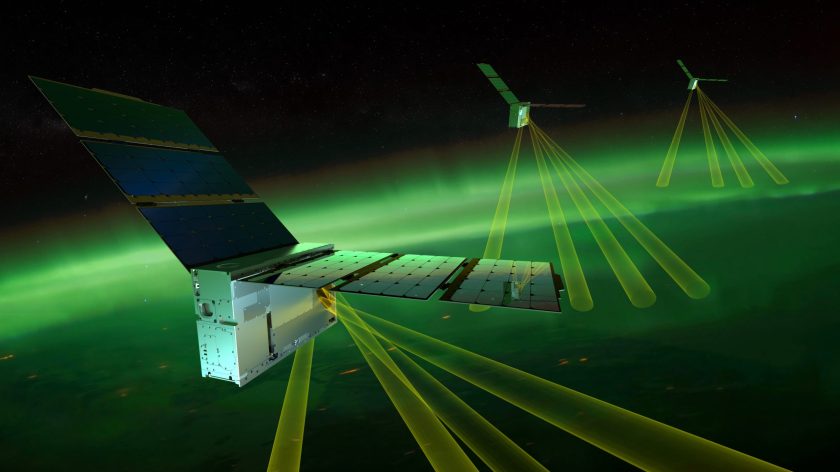
NASA’s EZIE (Electrojet Zeeman Imaging Explorer) is the first mission dedicated to studying auroral electrojets. These intense electrical currents flow in Earth’s upper atmosphere in both the northern and southern polar regions and are associated with the spectacular auroras (commonly known as the northern and southern lights).
The EZIE mission uses three CubeSats. Each of these small satellites, roughly the size of a carry-on suitcase, carries a compact science instrument to observe the magnetic “fingerprints” of the electrojets.
Lined up like pearls on a string, the EZIE spacecraft will orbit from pole to pole approximately 260 to 370 miles (420 to 590 kilometers) above Earth’s surface.
The EZIE spacecraft do not carry any propulsion to adjust the separation between the three spacecraft. Instead, they use drag. As they travel at about 5 miles (8 kilometers) per second, the spacecraft will carefully rotate to change the atmospheric drag and thereby adjust their separation. This will allow each successive spacecraft to fly over the same region 2 to 10 minutes after the former.
The auroral electrojets flow at roughly 65 miles (100 kilometers) above Earth’s surface, pushing up to 1 million amps of electrical current around the poles.
The EZIE satellites will map the electrojets by observing microwave emission at a frequency of 118 gigahertz from oxygen molecules located about 10 miles (16 kilometers) below the electrojets. The electrojets create a magnetic field that leaves a “fingerprint” in the oxygen’s emission, which EZIE is designed to measure. During every orbit, each EZIE spacecraft will produce a map of the electrojets, detailing their structure. Combining the maps from the three spacecraft will show how the electrojets evolve.
By revealing how the electrojets are structured and evolve, EZIE will not only help scientists understand how these currents connect Earth and the surrounding space, but the data will help researchers create more accurate and powerful models for predicting space weather events.
Insights from EZIE will apply not only to our own planet but also to any magnetized planet in our solar system and beyond.
The EZIE team is also distributing EZIE-Mag magnetometer kits across the United States to allow students and citizen scientists to make their own scientific measurements of the Earth-space electrical current system. Scientists will combine EZIE-Mag data with EZIE measurements made from space to assemble a clear picture of this vast electrical current circuit.
The three EZIE spacecraft are launching aboard a SpaceX Falcon 9 rocket from Vandenberg Space Force Base in California as part of the Transporter-13 rideshare mission with SpaceX via launch integrator Maverick Space Systems.
The mission is scheduled to operate for 18 months.
The Johns Hopkins Applied Physics Laboratory in Laurel, Maryland, leads the EZIE mission for NASA. Blue Canyon Technologies in Boulder, Colorado, built the CubeSats. NASA’s Jet Propulsion Laboratory in Southern California built the Microwave Electrojet Magnetogram, which will map the electrojets, for each of the three EZIE satellites.
